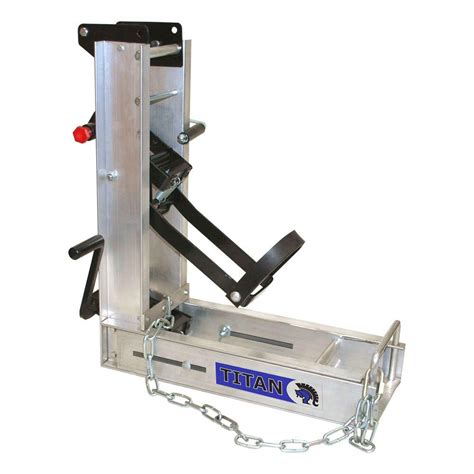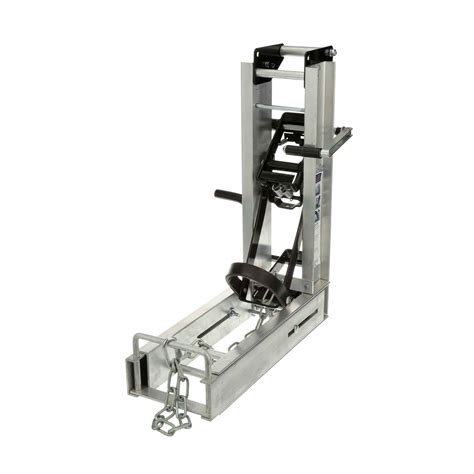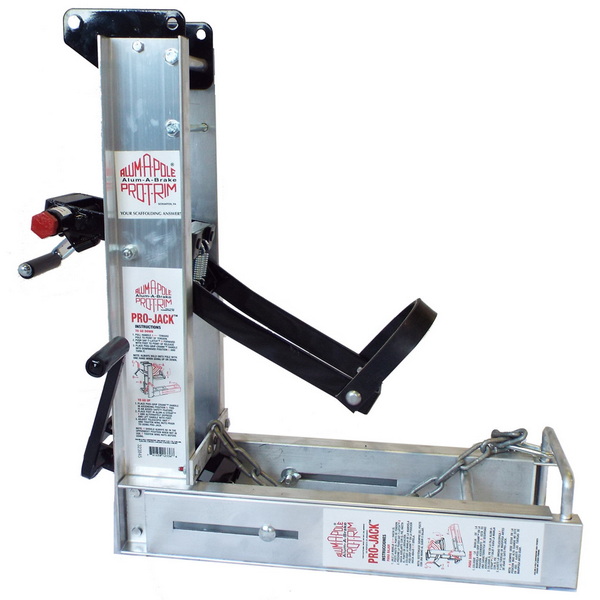Content Menu
● Introduction to the Titan Aluminum Pump Jack Scaffold System
● Components of the Titan Aluminum Pump Jack Scaffold System
● Step-by-Step Assembly Guide
● Safety Protocols
● Advantages of the Titan Aluminum Pump Jack Scaffold System
● Potential Challenges and Mitigation Strategies
● Best Practices for Safe Usage
● Conclusion
● FAQ
>> 1. What is a pump jack system used for?
>> 2. How high can the Titan Aluminum Pump Jack Scaffold System reach?
>> 3. Is the Titan Aluminum Pump Jack Scaffold System OSHA-compliant?
>> 4. What should I do if I find a damaged part on the scaffold system?
>> 5. Can I use the pump jack system in windy conditions?
● Citations:
The Titan Aluminum Pump Jack Scaffold System is designed to provide a safe and efficient scaffolding solution for various construction and home repair projects[1][5]. This system allows professionals to easily raise and lower a work platform, reaching heights up to 48 feet while maintaining stability and adhering to safety standards[1][5]. This article explores the features, assembly, usage, and safety protocols of the Titan Aluminum Pump Jack Scaffold System, highlighting how it ensures maximum safety for workers.

Introduction to the Titan Aluminum Pump Jack Scaffold System
The Titan Aluminum Pump Jack Scaffold System is a type of supported scaffold widely used in the construction industry[5]. It is particularly useful for tasks such as shingling, siding, insulating, roofing, and general home repair[1][5]. The system's primary components include aluminum pump jacks, aluminum poles, pole feet, braces, and a work platform[5].
Key Features:
- Height Adjustability: The system allows workers to adjust the height of the platform up to 48 feet, providing flexibility for different project requirements[1][5].
- Aluminum Construction: Made from lightweight yet durable aluminum, the system is easy to transport and assemble while maintaining structural integrity[1][5].
- OSHA Compliance: The Titan Aluminum Pump Jack Scaffold System is designed to meet OSHA (Occupational Safety and Health Administration) safety standards, ensuring a safe working environment[1][5].
Components of the Titan Aluminum Pump Jack Scaffold System
Understanding the individual components of the Titan Aluminum Pump Jack Scaffold System is crucial for proper assembly and safe usage.
1. Aluminum Pump Jacks: These are the core components that provide the lifting mechanism for the scaffold platform[1][5]. The pump jacks attach to the aluminum poles and allow workers to raise or lower the platform by pumping a lever[1].
2. Aluminum Poles: Vertical supports that the pump jacks grip to ascend or descend. These poles are typically available in lengths of 6, 12, and 24 feet and can be connected using pole insert connectors to achieve the desired height[9].
3. Pole Feet: These provide a stable base for the aluminum poles. Options include rubber feet for flat, hard surfaces and pole anchors for soft or uneven terrain[9].
4. Braces: These are used to stabilize the scaffold system by connecting the aluminum poles to the structure being worked on[9]. Braces typically have swivel heads to accommodate different roof pitches and installation conditions[9].
5. Work Platform: This consists of aluminum stage planks that provide a safe and stable surface for workers to stand on[9]. These planks can be connected for a wider platform and should be secured to the pump jacks and workbench with chains[9].
6. Workbench: Provides additional support and stability to the platform[9].
7. Safety Net (Optional): Used to catch falling tools and materials, enhancing safety for workers and those below[5][9].
8. Guard Rails (Optional): Installed on open sides of the platform to prevent falls[9]. Safety codes generally require guard rails when the platform height is 10 feet or more[10].
Step-by-Step Assembly Guide
Assembling the Titan Aluminum Pump Jack Scaffold System correctly is essential for ensuring its safety and stability[9]. Here's a detailed guide:
1. Preparation:
- Ensure the worksite is free of construction debris[10].
- Inspect all components for damage or missing parts[10].
- Select the appropriate pole feet based on the surface conditions (rubber feet for hard surfaces, anchors for soft surfaces)[9].
2. Initial Setup:
- Position the aluminum stage plank against the wall[9].
- Align the aluminum poles with the plank[9].
3. Attaching Pump Jacks and Workbench:
- Place the aluminum pole on the ground with the rubber pad facing upward[10].
- Slide the bottom end of the pole through the top of the pump jack, ensuring the pump jack platform support faces the ground[10].
- Continue sliding the pole through the pump jack until it passes the lower foot lever, causing the lever to depress into the rubber surface of the pole[10].
- Pump the upper foot lever to advance the pump jack approximately one foot past the bottom of the pole[10].
- Attach the workbench to the pump jack and pole, securing it with nuts and bolts[10].
4. Erecting the Poles:
- Erect the pole by swinging it upwards or using a rope to hoist it, especially for pole combinations higher than 24 feet[9].
5. Installing Braces:
- Secure braces to the pole and fasten them to the structure of the building with brace screws[9].
- Use one brace for up to 24 feet of pole height and intermediate braces with a maximum of 16 feet vertical spacing for heights above 24 feet[9].
6. Securing the Platform:
- Secure planks to the pump jack and workbench using attached chains[9].
- When using planks on a three-pole setup, ensure the joint is secured directly over the pump jack and workbench using chains[9].
7. Installing Safety Features:
- Install the optional safety net to catch falling tools and materials[9].
- Install guard rails on all open sides of the platform, especially if the platform height is 10 feet or more[9][10].

Safety Protocols
Adhering to strict safety protocols is paramount when using the Titan Aluminum Pump Jack Scaffold System[10].
- Regular Inspections: Inspect the entire system upon receipt and at least once each day before each shift in use[10]. Check for damaged or missing parts and ensure all components are in good working condition[10].
- Proper Training: Ensure all workers are properly trained in the assembly, use, and safety procedures of the pump jack system[9].
- Weight Limits: Never exceed the specified weight limits of the scaffold system. Distribute weight evenly on the platform to prevent overloading[5].
- Weather Conditions: Do not use the system in inclement weather or high winds. Secure scaffold platforms against wind and uplift[10].
- Electrical Safety: Never use the system near electrical currents. Inspect all power tools and extension cords to ensure they are not damaged[10].
- Fall Protection: Use fall protection equipment such as safety belts, harnesses, lanyards, and lifelines in compliance with ANSI and OSHA standards[10].
- Guard Rails and Toe Boards: Install guard rails and toe boards on all open sides of the platform when the height is 10 feet or more[10]. Use safety screening to cover the space between the toe board and top guard rail[10].
- Overhead Protection: Provide overhead protection no more than 8 feet above the working plank or pedestrian walkway where overhead hazards exist[10].
- Securing Equipment: Secure all equipment to the scaffold platform to prevent tools or materials from falling[10].
- Chemical Exposure: Avoid exposing the aluminum components to acids and caustics, which can corrode the material and affect its strength[10].
Advantages of the Titan Aluminum Pump Jack Scaffold System
The Titan Aluminum Pump Jack Scaffold System offers several advantages over traditional scaffolding methods:
- Portability: The lightweight aluminum construction makes the system easy to transport and set up at different job sites[1][5].
- Efficiency: The pump jack mechanism allows for quick and easy height adjustments, saving time and labor[5].
- Versatility: The system is suitable for a wide range of applications, including siding, roofing, painting, and home repairs[1][5].
- Cost-Effectiveness: Investing in a pump jack system can be more cost-effective than renting or buying traditional scaffolding, especially for frequent users[3].
- Safety: Designed with multiple safety features and OSHA compliance, the system provides a secure working environment[1][5].
Potential Challenges and Mitigation Strategies
While the Titan Aluminum Pump Jack Scaffold System is generally safe and efficient, users should be aware of potential challenges:
Instability on Uneven Surfaces:
- Challenge: Soft or uneven ground can compromise the stability of the scaffold system[9].
- Mitigation: Use pole anchors instead of rubber feet for better stability on soft surfaces. Ensure the ground is properly compacted and leveled before setting up the system[9].
Overloading:
- Challenge: Exceeding the weight limits of the scaffold can lead to collapse and serious injury[5].
- Mitigation: Know the weight limits and distribute the load evenly across the platform[5].
Improper Assembly:
- Challenge: Incorrect assembly can compromise the structural integrity of the scaffold[9].
- Mitigation: Follow the manufacturer's instructions carefully and double-check all connections before use[9].
Weather Conditions:
- Challenge: High winds and inclement weather can make the scaffold unstable and dangerous[10].
- Mitigation: Avoid using the system in adverse weather conditions. Secure the platform and use extra bracing for added stability[10].
Lack of Training:
- Challenge: Untrained workers may not be aware of the proper safety procedures and risks associated with using the scaffold[9].
- Mitigation: Provide thorough training to all users, covering assembly, use, and safety protocols[9].
Best Practices for Safe Usage
To maximize safety when using the Titan Aluminum Pump Jack Scaffold System, consider the following best practices:
- Plan Ahead: Assess the worksite and plan the scaffold setup accordingly[10].
- Use Proper Tools: Use the correct tools for assembly and adjustments[10].
- Maintain Three Points of Contact: When climbing or working on the scaffold, maintain three points of contact at all times[10].
- Avoid Overreaching: Position the scaffold close enough to the work area to avoid overreaching[5].
- Communicate Clearly: Establish clear communication signals between workers on the scaffold and those on the ground[9].
- Stay Focused: Avoid distractions and concentrate on the task at hand[10].
- Report Issues: Report any damage, defects, or safety concerns immediately[10].
Conclusion
The Titan Aluminum Pump Jack Scaffold System is a versatile and efficient solution for working at heights, offering numerous benefits for construction and home repair projects[1][5]. By understanding its components, following proper assembly procedures, adhering to strict safety protocols, and implementing best practices, users can ensure maximum safety and minimize the risk of accidents[9][10]. Regular inspections, thorough training, and a commitment to safety are essential for making the most of this system while keeping workers safe[10].

FAQ
1. What is a pump jack system used for?
Pump jack systems are perfectly suited for siding jobs[5]. They are also great for other projects like roofing, shingling, chimneys, insulating, gutters, and repairs[1][5].
2. How high can the Titan Aluminum Pump Jack Scaffold System reach?
The Titan Aluminum Pump Jack Scaffold System can raise a scaffolding platform up to 48 feet high[1][5].
3. Is the Titan Aluminum Pump Jack Scaffold System OSHA-compliant?
Yes, the Titan Aluminum Pump Jack Scaffold System is designed to meet OSHA (Occupational Safety and Health Administration) safety standards, ensuring a safe working environment[1][5].
4. What should I do if I find a damaged part on the scaffold system?
Never use equipment with damaged or missing parts[10]. Discard the damaged part or contact the manufacturer for repair or replacement[10].
5. Can I use the pump jack system in windy conditions?
It is not recommended to use the system in inclement weather or high winds[10]. Windy conditions require extra caution, and scaffold platforms must be secured against wind and uplift[10].
Citations:
[1] https://homeimprovementsupply.com/p-10064-titan-aluminum-pump-jack.aspx
[2] https://www.youtube.com/watch?v=rOZLvSxr_f4
[3] https://www.festoolownersgroup.com/other-tools-accessories/anyone-with-aluminum-pump-jack-system-experience/
[4] https://patents.google.com/patent/CN110185826B/zh
[5] https://www.badgerladder.com/aluminum-pump-jacks/
[6] https://www.facebook.com/badger.ladder/videos/how-to-put-a-pump-jack-system-together/753797468120086/
[7] https://www.reddit.com/r/Construction/comments/14kq2dr/opinions_on_pump_jacks_im_about_to_use_one_for/
[8] https://www.ee.cityu.edu.hk/~gchen/pdf/Writing.pdf
[9] https://www.youtube.com/watch?v=BUAO-ZQYZ_k
[10] https://www.badgerladder.com/pdfs/titan-safety-instructions.pdf
[11] https://dallasladder.com/pump-jack-titan-aluminum/






















